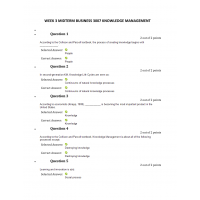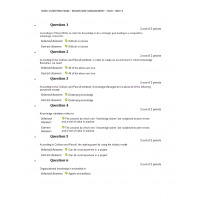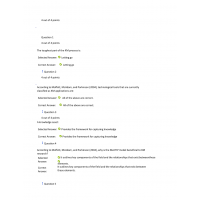BUSI 3007 Final Exam 2
BUSI 3007 Final Exam 2
1. Collison and Parcell discuss steps to embed the knowledge management process within organizations. In which of these steps is it important to demonstrate a "quick win"?
2. According to Collison and Parcell, everyone has .
3. All of the following are common assumptions for why connection tools may not be needed in small organizations EXCEPT:
4. The stage in the life cycle of communities where needs are identified is:
5. Which of the following is not a part of the holistic model?
6. According to Collison and Parcell, the acronym AAR means:
7. A measure of the success of BP Connect was:
8. A knowledge asset:
9. Collison and Parcell discuss steps to embed the knowledge management process within organizations. In which of these steps does the team link their efforts to other business processes?
10. According to Collison and Parcell, the real learning in AAR comes when you:
11. An approach used for deciding what knowledge to capture from an individual includes:
12. The toughest part of the KM process is:
13. According to Moffett, McAdam, and Parkinson (2004), the correct perspective of IT in the KM area should be:
14. According to Moffett, McAdam, and Parkinson (2004), what does the MeCTIP model show?
15. Relationship building is a key component of knowledge sharing. It is recommended to ask people to answer which type of questions?
16. Defining communities is an important part of the knowledge sharing process. Which of the following are stewards of competencies?
17. Delivery networks provide:
18. In order to be most effective, the scope of a knowledge asset must be:
19. Writing a frequently asked questions (FAQ) list based on the knowledge of the expert who is leaving is part of which phase of the knowledge capture process?
20. According to Moffett, McAdam, and Parkinson (2004), technological tools that are currently classified as KM applications are:
21. Enabling networks provide:
22. A useful tool in facilitating connections is:
23. According to Moffett, McAdam, and Parkinson (2004), in today's knowledge-intensive organizations, the primary objective of ICT is to:
24. According to Collison and Parcell, making connections is an important point of sharing knowledge within organizations. The recommended approach is:
25. According to Collison and Parcell, a "river diagram" shows:
| Institution & Term/Date | |
| Term/Date | Walden University |
-
$30.00








